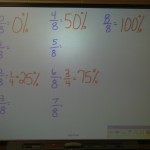Frog races have been a part of my math teaching for a while now. It’s fun! It’s exciting! It’s unpredictable! But we try to predict it anyway! We don’t use live frogs (just in case you were wondering). We use stuffed frogs. I’ve made a giant race track out of a huge piece of felt by drawing a 6 x 12 grid on it. We race six frogs and they are lined up at one end of the track. Before we begin I ask each student to predict who will win that day’s race. The frogs are numbered one through six. They all have names, of course, and are more often referred to by their names. Just in case you are curious, frog 1 is Mr. Polyester, frog 2 is Lightning, frog 3 is Fatty, frog 4 is Smoochee, frog 5 is Leaper, and frog 6 is Bobby Bo. The students take turns racing the frogs. The rest of the students are our spectators.
Once predictions have been made, I walk around to the spectators and ask them to shake three dice. What they roll determines which frogs move. Let’s say the first person shakes two 4’s and one 2. That would mean that frog 4 (Leaper) would move two squares, and frog 2 (Lightning) would move one square. It’s as simple as that. We keep going until a frog has crossed the finish line. It gets pretty exciting when there are two, three, or four frogs in a tie for the lead!
Once we have established a winner, then the students head back to their desks to fill out their data sheet. I also send someone to update the bar graph we have on the wall in our room. The bar graph has a picture of each frog at the bottom of the column they represent. Their frog number is at the top of the graph.
The students keep track of each week’s results in a notebook. They record the date, the frog they predicted would win, the frog who actually won, the fraction of times they have predicted correctly, and the percentage of times they have predicted correctly.
Next I list on the board all of the possible fractions for this race. On this particular day it was our 8th race so a person might have guessed right either 0/8, 1/8, 2/8, 3/8, 4/8, 5/8, 6/8, 7/8, or 8/8 of the time. I asked the students to tell me the equivalent percent for each fraction listed. I asked them to start with the obvious ones … such as 0/8 = 0% and 8/8 = 100%. Then someone recognized that 4/8 = 50%. Well, if there was a 50%, I wondered out loud if there would be a 25% or 75%. Immediately hands shot up as students recognized that 2/8 = 1/4 = 25% and that 6/8 = 3/4 = 75%. Once we had that much figured out, I asked if we could figure out the rest of the percentages without a calculator. Again, some students recognized that 1/8 was half way between 0/8 and 2/8, so 1/8 would be half of 25% . Then there was a scramble of hands up because once the pattern had been established, figuring out the rest of the percentages became fun!
The very last step is to ask the students to come up to the board and place a tally mark below the percentage that represents their personal data on predicting frog races. Back when we had only raced twice, we had some students who had been right 50% of the time. Currently, the best percentage is 38%. Two students are still at 0% correct predictions. It is good practice to talk about what observations one can make by looking at data.
In the weeks to come, we will continue to enjoy the excitement of the race, but then also become very familiar with writing fractions as percents. The students will also begin to recognize that some fractions are easy to write as a percentage if you simplify them first. Other fractions (with a prime number denominator) require you to get out your calculator!
Besides the fraction to percent work, it is also interesting to figure out what the chances are of shaking three of any number. I could tell you how, but instead I challenge you to find out and submit your answer as a comment to this post. The first person to post with a correct answer wins $50 froggy buck! Go for it!
Note for teachers: This activity takes about 20-25 minutes.















